Plastic is an essential material in countless products, from packaging to household items. But have you ever wondered how plastics achieve their vibrant colors? The process of coloring plastics is intricate, involving different methods that ensure consistency and durability. In this article, we’ll delve into “how is plastic colored”. Whether you’re a professional in the industry or just curious, this guide will provide a clear understanding of coloring plastic.
1. How Is Plastic Colored? – Common Methods of Coloring Plastics
Coloring plastic requires specialized techniques to achieve consistent results, each with unique applications and benefits. Here are the main methods used to infuse color into plastics:
1.1. Masterbatch Coloring

Masterbatch is a concentrated mixture of pigments or additives that are dispersed into a carrier resin. This is then blended with natural or uncolored plastic granules during the molding process. The benefit of using masterbatch is that it provides precise control over color intensity and consistency. It is widely preferred for its ease of use and ability to produce rich, vibrant colors.
Read more: Color Masterbatch: Unlocking 1000+ Shades for Your Products
1.2. Compounding

Compounding involves thoroughly mixing the plastic resin with colorants and other additives before the molding process. This method ensures uniform dispersion of pigments throughout the material, resulting in a consistent hue. Compounding is ideal for complex applications where the desired color must remain consistent throughout the entire batch of plastic.
1.3. Dry Coloring

Dry coloring is a simple method where powdered pigments are mixed directly with the plastic resin. While this process is less expensive, it requires careful handling to avoid dust and ensure even distribution of color. Dry coloring is suitable for applications where slight variations in color are acceptable, making it a popular choice for non-aesthetic products.
1.4. Liquid Color

Liquid color involves adding liquid pigments into the plastic resin. This method offers excellent dispersion and is efficient for large-scale production. Liquid color is often used when working with plastics that have complex shapes or where a high degree of transparency is required. However, it requires specialized equipment for mixing, making it less practical for small-scale production.
2. What Factors Affect Plastic Coloring?
Several factors can influence “how is plastic colored,” impacting the final appearance and quality of the colored plastic. Key factors include:
- Type of Resin: Different resins interact uniquely with colorants, influencing how well a colorant will disperse and bond with the plastic.
- Pigment Compatibility: Some pigments work better with certain plastics than others. Choosing the right pigment is crucial to achieving the desired color and preventing issues like streaking.
- Processing Conditions: Temperature, pressure, and mixing speed during the molding process can all affect how evenly the color is distributed.
- Environmental Stability: Factors like UV exposure and humidity can cause colors to fade or change over time. Additives may be used to enhance the durability of the color in outdoor applications.
3. FAQs About Coloring Plastic
What do they use to color plastic?
Plastic is colored using a variety of pigments, dyes, and concentrates like masterbatch, dry colors, or liquid colorants. The choice of colorant depends on the desired shade, plastic type, and production process.
Can plastic be colored at home?
Yes, coloring plastic at home is possible, especially for small DIY projects. It requires basic materials like fabric dyes or specialized plastic dyes. However, results may vary compared to industrial methods due to limited control over consistency and dispersion.
How to color plastic at home?
To color plastic at home, you can use dyes or paints specifically designed for plastics. Clean the surface thoroughly, lightly sand it if needed, and apply the dye or paint evenly. Allow adequate drying time to ensure the best results. Note that for small items, heating the plastic gently can help the dye bond better with the material.
Conclusion
Understanding “how is plastic colored” involves exploring the different methods and factors that impact the final product. From masterbatch and compounding to dry and liquid coloring, each technique has its own advantages depending on the requirements of the application. The choice of method is influenced by factors like resin type, processing conditions, and pigment compatibility. Whether you’re considering industrial production or a simple home project, knowing the basics of “coloring plastic” can help you achieve the desired results.
